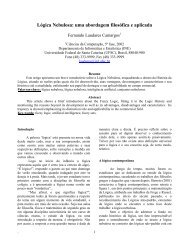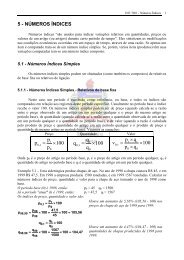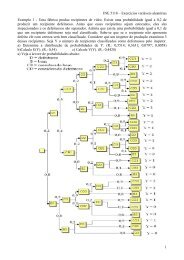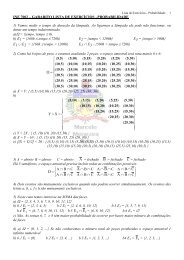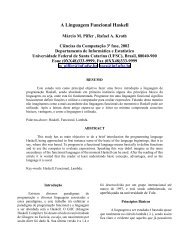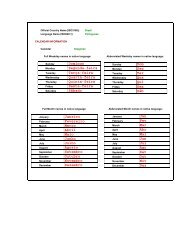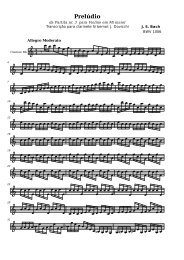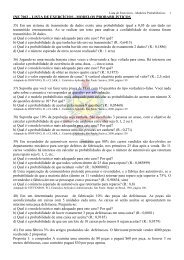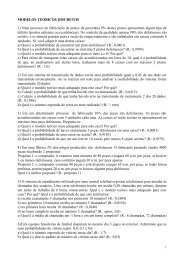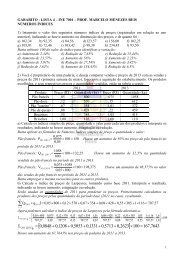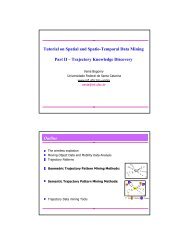Anais do IHC'2001 - Departamento de Informática e Estatística - UFSC
Anais do IHC'2001 - Departamento de Informática e Estatística - UFSC
Anais do IHC'2001 - Departamento de Informática e Estatística - UFSC
You also want an ePaper? Increase the reach of your titles
YUMPU automatically turns print PDFs into web optimized ePapers that Google loves.
<strong>Anais</strong> <strong>do</strong> IHC’2001 - IV Workshop sobre Fatores Humanos em Sistemas Computacionais 75<br />
perform the same typical tasks and to follow the same guidance given to non-expert<br />
evaluators.<br />
After reducing all usability problems, <strong>de</strong>scribed by all evaluators, to a list of unique<br />
problems, the researcher asked the participants to assign a severity rating to each problem<br />
listed, according to the following scale:<br />
• 0 - this is not a usability problem;<br />
• 1 - low severity problem (cosmetic);<br />
• 2 - mo<strong>de</strong>rate severity problem (obstacle);<br />
• 3 - high severity problem (catastrophe).<br />
Research Results and discussion<br />
During the usability inspection of the sample corporate portal, 56 web pages were visited.<br />
The participants of this research reported and <strong>de</strong>scribed 701 usability problems, which<br />
were reduced to 120 unique problems, after verbal logic analysis of all <strong>de</strong>scriptions. The<br />
unique problems were associated to numerical co<strong>de</strong>s categorized into seven usability<br />
factors, <strong>de</strong>rived from usability heuristics <strong>de</strong>fined by Nielsen (1994):<br />
• Consistency;<br />
• Context compatibility;<br />
• Error prevention;<br />
• Flexibility and efficiency of use;<br />
• Aesthetics and simplicity;<br />
• User control;<br />
• Visibility, recognition and conduction.<br />
Due to overlapping between usability factors, 14 usability problems were classified<br />
in more than one category. For this reason, the total of usability problems, in some aspects<br />
of this data analysis, may be 134, corresponding to 14 duplicated problems ad<strong>de</strong>d to the<br />
previously mentioned total of 120 unique problems.<br />
Most of the usability problems reported (68%) were consi<strong>de</strong>red of mo<strong>de</strong>rate<br />
severity, according to evaluators' answers. 'User control' and 'Error prevention' problems<br />
got the highest average severity ratings (1,93 and 1,69, respectively - in a scale from 0 to<br />
3). This result is compatible with Nielsen's statement : error situations or actions that <strong>do</strong> not<br />
follow user's commands are critical for usability because they represent situations where<br />
the user is in trouble and potentially unable to use the system to achieve the <strong>de</strong>sired goal<br />
(Nielsen, 1993). Therefore, web pages need to behave according to user expectations,<br />
responding to his commands and mouse clicks, and avoiding errors. Otherwise, users may<br />
give up using the corporate portal to search information or to complete specific tasks.<br />
Based on evaluators' opinions, context compatibility, legibility, efficiency,<br />
effectiveness and attractiveness were the positive aspects of the sample corporate portal.<br />
On the other hand, the confusing <strong>de</strong>sign of this web portal was the satisfaction item that<br />
reached the highest percentage of negative scores (40% of the evaluators' answers), for<br />
being such a usability obstacle to the completion of the typical tasks (17% of the evaluators



